In this article, we will discuss what Web3 and Metaverse really mean and what tools they use to protect users’ identities.
What is Web3 and how does it handle data?
Web3 is the evolution of the internet in which users do not only interact with content (as in Web 2.0), but also own part of the network. For this reason, to understand what Web3 is, we must necessarily talk about how data is processed and how user data is used, stored and protected.
In Web 2.0, data was stored and controlled on large servers of technology companies. This eventually gave rise to a number of privacy concerns, stemming from data collection, lack of transparency and the difficulty for users to decide on their personal data.
For this reason, among others, work was done on what is known today as Web3. It uses blockchain technology to decentralise the control and storage of data. As a result, users have more control over their personal Information and can decide how they use the internet.
What is the Metaverse and how does it handle data?
Metaverse is the generic name given to the different virtual environments that develop on the Internet. This virtual world offers new ways of interacting with digital content, thanks to the use of VR headsets such as the Meta Quest glasses. One example is Movistar Immersive Experience.
In the Metaverse, we encounter the same problems as in the “traditional” web, which is why the solutions are the same. We need to understand that the Metaverse is not a way of dealing with user data, but rather, it can be considered a form of web development architecture. It is just like any other website that you can visit from your mobile or computer, but designed in a three-dimensional way and more interactively.
Fortunately, in the programming of immersive spaces, developers tend to rely heavily on the Web3 culture, so from the outset they are designed as platforms where users have more control over themselves.
Tools for data protection in Web3 and Metaverse
As you have seen, Web3 and Metaverse are not the same thing, but they are closely related, because Web3 fundamentals make the Metaverse a more secure space thanks to the implementation of:
- The blockchain is the main form of decentralisation of information. It is based on the creation of a single record, but at the same time multiple synchronised copies are generated, making it impossible to maliciously alter data.
- Smart contracts, based on blockchain technology, are computer programmes stored on blockchains that are automatically executed when the agreed conditions are met. This allows for transparency and security, as there is no need for an intermediary.
- Decentralised digital identity, the characteristics of the Web3 give users the ability to associate and disassociate attributes that identify them on the Internet. This does not mean that you can change your identity and become someone else, it is about the user controlling their digital identifier and deciding how much about themselves they want to share when they identify themselves on the Internet.
- Telefónica Open Gateway APIs, the Open Gateway initiative that uses the capabilities of the network to develop standardised APIs that make it easier for developers to establish security measures in their services and products that protect users’ digital identities.
Telefónica is committed to user security, which is why it has joined forces with the non-profit organisation Celo, which manages the development of blockchain and is working on the development of digital identity security APIs in the Telefónica Open Gateway initiative.
